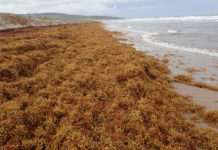By: Emily J. McCorkell
The Rise Of Nutraceuticals
Looking For Super Foods But Don’t Know Where To Turn? Seaweed From The Oceans!
It’s no secret that people are wary of Big Pharma and popping pills just to sustain a certain quality of life. This skepticism, and increasing pharma-angst, have given way to the rise
of nutraceuticals, which essentially are nutritional supplements.
What an age in which to be pursuing health! In today’s world, consumers have a voice and ability to exercise their consciences about where their products have come from, the genuine health factors, and the sustainability of product and producer. Companies are
required to be transparent in their practices, and accountable to the consumer.
We have taken our health back into our hands—and it never should have left! A nutraceutical is really just a new term for nutritional supplement: a product from a food source that provides extra benefits. These benefits can be to aid in the normal function of the body, help prevent chronic diseases, boost immunity, delay aging processes, and improve overall health and well-being, both physical and psychological. One of the top nutraceuticals is found at the bottom of the ocean – Seaweed.
Despite common perception as an Asian food—if a food at all—it famously is used in Miso soup and sushi. But edible seaweed is found in all oceans and has been consumed in many cultures. In Ireland, where I live now, the legendary potato famine of the 1840s, obliged marine villages like Dungloe to survive on nothing but Dulse, a shallow-water, nutrientdense seaweed. Although just living on seaweed and water sounds like a death sentence, the small population survived. Dulse is twice as nutritious as kale, and contains
over 15 percent protein by dry weight!
By the way, if you want non-Asian seaweed inspiration, try drying Dulse and flaking it over meals as a seasoning. Or take full leaves of this sea lettuce and fry it up! It has a super savory, almost bacon-like flavor. It is the perfect savory, meaty-textured food for vegans, vegetarians, or those looking to cut down their meat consumption.
The immediate question for many readers will be: That’s fine for Japan or the coast of Ireland, but what about the U.S.? Our editor has checked what I knew before I moved here: many seaweed products, in many forms, are available in the larger supermarkets,
in Asian food stores, and in health food shops.
There are many types of seaweed: Kelp, Dulse, Wakame, Sea Spaghetti, Nori, Arame, Hijiki, and Kombu, just to name a few. Varieties of seaweed grow in cool waters and are able to easily absorb the vast, hearty nutrients from their growing environment. This is why
seaweed is so good for us:
- Low calorie
- Low lipids
- High concentration of minerals, vitamins and proteins, including Magnesium, Calcium,
Phosphorus, Potassium and Iodine. - Dietary Fiber ranges from 30 to 75 percent in dried weight
- It is an antioxidant, antimutagenic, has an anticoagulant effect, and has been recognized to increase antitumor activity.
HEALTHY IDEAS FROM LO & SLOW
ARE YOU HUNGRY YET? Let’s really get that summer beachy glow by cooking up some beach food! Here are some ways to enjoy your new favorite nutraceutical.
DRIED NORI SHEETS are common in most supermarkets or bodegas. It is the seaweed used in sushi. Crumble some dried Nori on top of a dish. Or crush into a powder and use it as a base for stock, or seasoning in sauces or dressings. It is the perfect secret ingredient!
Make a Wakame slaw to top burgers, salads, or just eat forkfuls at a time! Seriously, it’s that good! Here’s what to do:
- Prep Wakame and cabbage: thinly slice both, roughly one 8-inch piece of Wakame and 3 cups cabbage. Blanch in hot water for 10-15 seconds. Then immerse in cold water until completely cooled. Drain well and set aside.
- Shred three carrots, four radishes, one peeled Granny Smith apple, and two turnips. Add to the cabbageWakame mixture. Either dress in three Tablespoons rice vinegar with one
teaspoon sesame oil; or make a mayobased dressing with three Tablespoon smayonnaise, one Tablespoon honey, two teaspoons black pepper, and vinegar to taste. Add flaked seaweed or spring onions to garnish. Enjoy! - Seaweed Chips: Similar to kale chips,but so much more nutritious and naturally delicious! Prepare the same way you would the kale chips: rinse, dry, and toss the seaweed in oil. Layer on a baking sheet and bake at 250 degrees until just crisped through, between 25- 40 minutes depending on the size of your seaweed. Toss in seasoning once cooked. Chili and lemon pepper is a favorite of mine! What’s yours
If you can’t “stomach” the taste of seaweed, you do not have to forego their benefits! There is a large variety of dried seaweed capsules you can source. Be sure to find a reputable producer. And, as always, buying local builds local community! See if any local health stores can source these products for you.
Don’t forget to get in touch! I’d love to see how you make Lo & Slo your own flavor. Tag me at #LoAndSlo on social media. Best wishes to Kyyba: Health & Life!
















